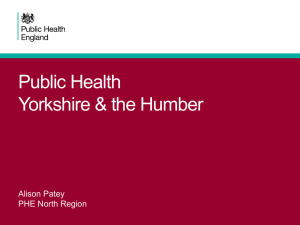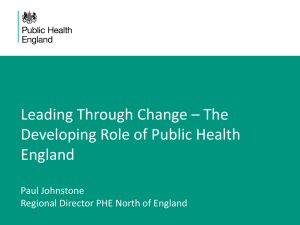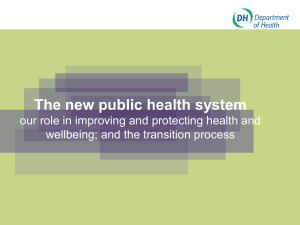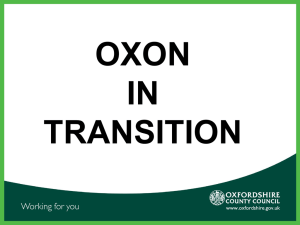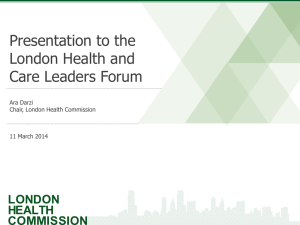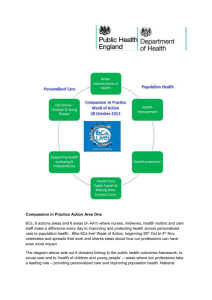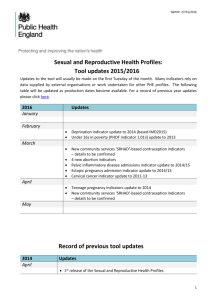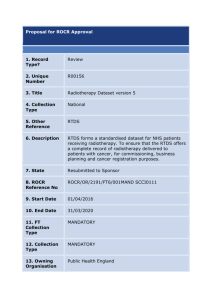Pete Burkinshaw`s presentation
advertisement
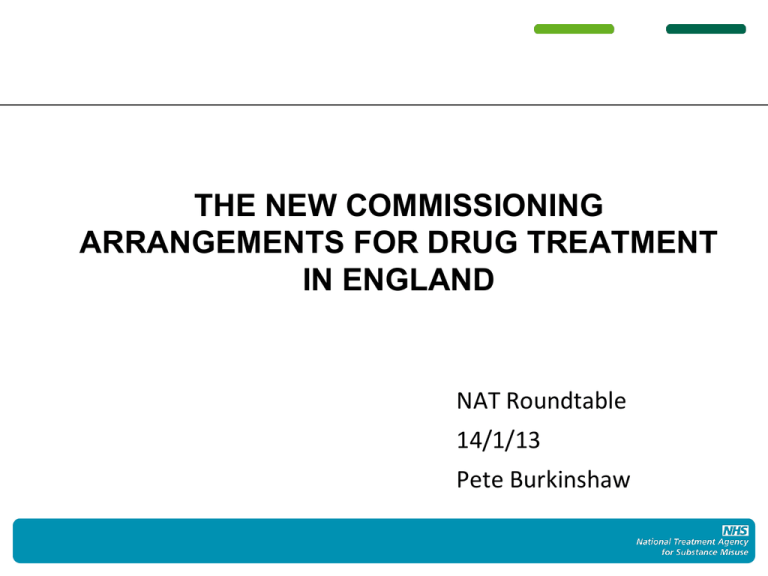
THE NEW COMMISSIONING ARRANGEMENTS FOR DRUG TREATMENT IN ENGLAND NAT Roundtable 14/1/13 Pete Burkinshaw Overview • Key Policy drivers and context • The architecture • Opportunities and challenges • Public Health England Key policy drivers • Localism • Transparency and accountability • Public health and health inequalities • Recovery • Payment by results 3 2010 drug strategy: ‘…all services are commissioned with the following best practice outcomes in mind’ • Freedom from dependence on drugs or alcohol; • Prevention of drug related deaths and blood borne viruses; • A reduction in crime and re-offending; • Sustained employment; • The ability to access and sustain suitable accommodation; • Improvement in mental and physical health and wellbeing; • Improved relationships with family members, partners and friends; and • The capacity to be an effective and caring parent. Recovery, integration and sense of place 5 This shift will provide a platform for a more integrated approach to improving public health outcomes. This approach addresses the root causes and wider determinants of drug dependence and alcohol misuse, and the harm and impact they have on communities and troubled families (such as mental health, employment, education, crime and housing). It also delivers the greatest gains for individuals and the community. (NTA/DH 2012) Context: Suite of evidence-based clinical guidance • In total there are 15 NICE drug and alcohol publications • Q1 13/14 NICE commitment to reflect all these in in LA PH briefing. The evidence ... ... is good that OST: Retains people in treatment Suppresses illicit use of heroin Reduces crime Reduces the risk of BBV Reduces risk of death. ... is less persuasive that OST: Suppresses other drug use Improves physical and mental health Improves social reintegration of marginalised heroin users Promotes abstinence from all drugs. Guidance……. 11 The treatment system’s achievements The new health and care system Local people and communities Police and Crime Commissioners could have a seat. Up to each LA Undertake JSNA & develop HWB Strategies setting out local priorities The evidence in this presentation can inform the JSNA and HWB Strategies. Health and Well-being Board Local Authorities PHE Centres Responsible for publishing data and supporting delivery of PHOF CCG/NHS CB Commissioning OF – set by the NHS CB for CCGs HealthWatch Accountability Oversight Links PHE Sets out the indicators that the PH system & DH understand are the best mechanisms to improve public health. Up to LAs to prioritise. Slide 16 NHS CB PHOF ASCOF NHSOF Mandate – only means of holding the CB to account Secretary of State for Health Parliament Sets out the indicators that the NHS should seek to achieve through the Mandate objective of continuous improvement 16 Architecture Drugs and alcohol services commissioned by local authorities, through Directors of Public Health Supported by and coordinated through Health & Wellbeing Boards Joint Strategic Needs Assessments (JSNAs) and Joint Health and Wellbeing Strategies (JHWSs) Ring fenced public health budget From DH & Public Health England (PHE) NTA functions transferred to PHE –April 2013 Public health outcome indicators Purpose but not how 17 18 Timely access to substance misuse treatment is one way of reducing health inequalities across many public health indicators; it (1) Supports Public Health Outcomes Framework (PHOF) vision: To improve and protect the nation’s health and wellbeing, and improve the health of the poorest fastest. (2) Impacts directly on both of the PHOF outcomes: • Outcome 1: Increased life expectancy • Outcome 2: Reduced differences in life expectancy and healthy life expectancy between communities (3) Contributes to many of the outcome indicators. Substance misuse treatment contributes to over half of the PHOF outcome indicators. Slide 19 19 Budgets 20 13/14 and 14/15 Budgets released on Friday • £2.66 billion and £2.79 billion to LAs to spend on public health services for their local populations. Average growth of 5.5% in 2013-14 and 5.0% in 2014-15 • ‘Currently, on average, about one third of spending is connected to mandated services, leaving a significant opportunity to commission services that meet the needs of your population. Services not currently covered by the mandating regulations include obesity, smoking cessation and substance misuse.’ • Mandated services: sexual health services; duty to ensure there are plans in place to protect the health of the population; public health advice to NHS commissioners; National Child Measurement Programme; NHS Health Check. The Public Health Grant • Local authorities will need to forecast and report against the subcategories of spend in returns to Public Health England who will review them on behalf of the Department of Health. • ‘Pace of change’ to a target budget position (12/13 PTB formula will affect target position within pace of change parameters) • Substance misuse component includes: PTB; DH DIP; YP; local drug and alcohol spend • Prison treatment to NHS Commissioning Board • HO DIP funding (£35M) to Police and Crime Comissioners More opportunities and challenges Unintended consequences: old new Balanced systems – maintaining gains Clinical Governance Priorities competing for scarce resources Commissioning skills: making the case for investment and developing alliances Complexity, dual diagnosis and health Medicines and new drugs and patterns of use Creativity – ABCD, social enterprises, recovery communities Engage PCCs, local Police and the crime reduction agenda 23 Public Health England Substance misuse personnel in: • Operations Directorate (PHE Centres) • Health and Wellbeing Directorate • Knowledge and Intelligence (NDTMS) • Drugs, Alcohol, ATMs and prevention • Evidence • Transparency • Support and mirror • BBV and DRD guidance due soon Director of Health Improvement and Population Healthcare for Public Health England Kevin Fenton, M.D., Ph.D., is the Director of the National Centre for HIV/AIDS, Viral Hepatitis, STD, and TB Prevention (NCHHSTP) at the U.S. Centres for Disease Control and Prevention (CDC). He joined the CDC in 2005 as the Chief of the Syphilis Elimination Effort, and in 2006 began his tenure as the Director of NCHHSTP. Prior to the CDC, Dr Fenton was the Director of the Health Protection Agency (HPA) HIV and Sexually Transmitted Infections Department where he led the development, implementation and evaluation of numerous national and European HIV and STD surveillance, prevention, screening, and research programs. Public health - broad and diverse, so is treatment. 26

